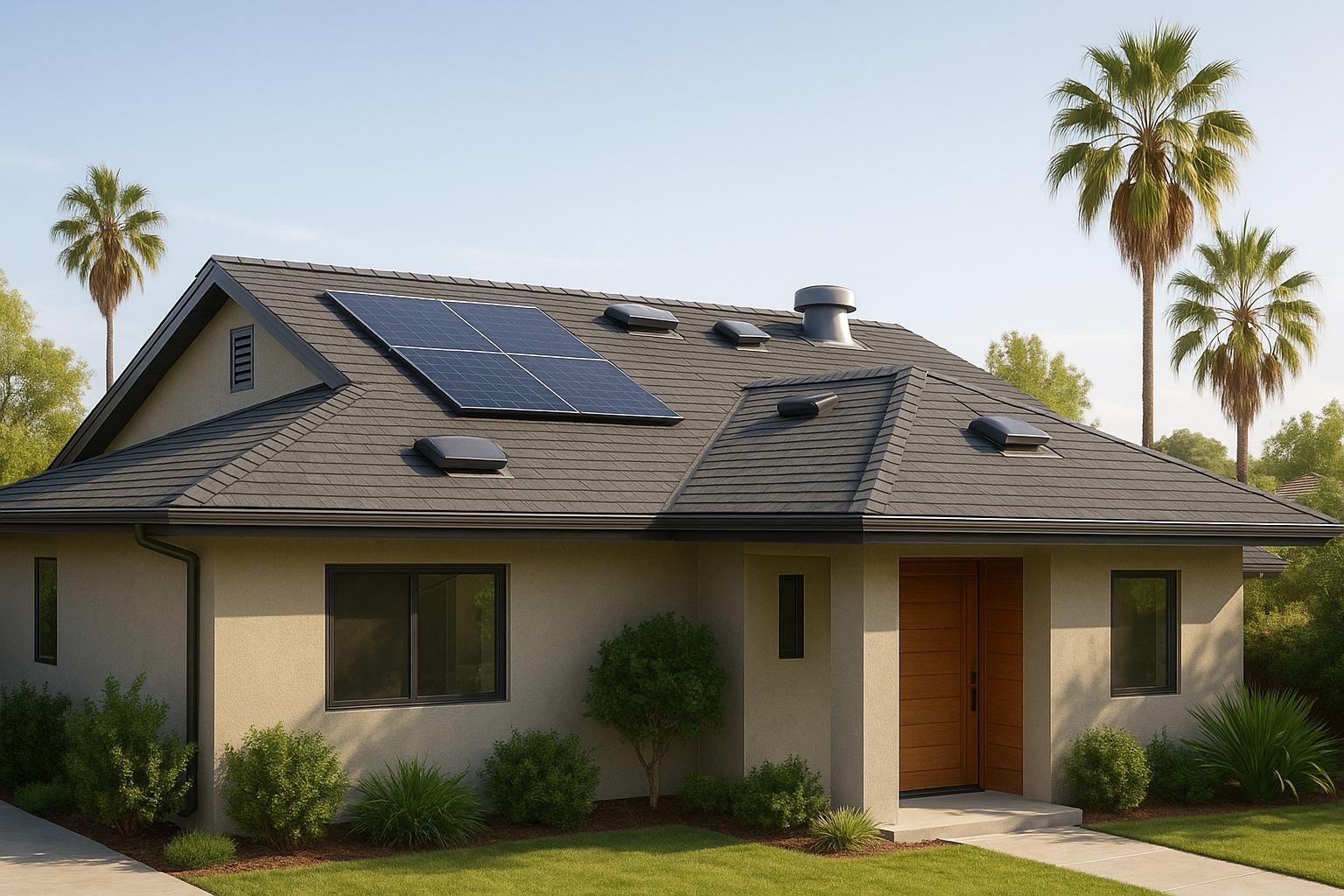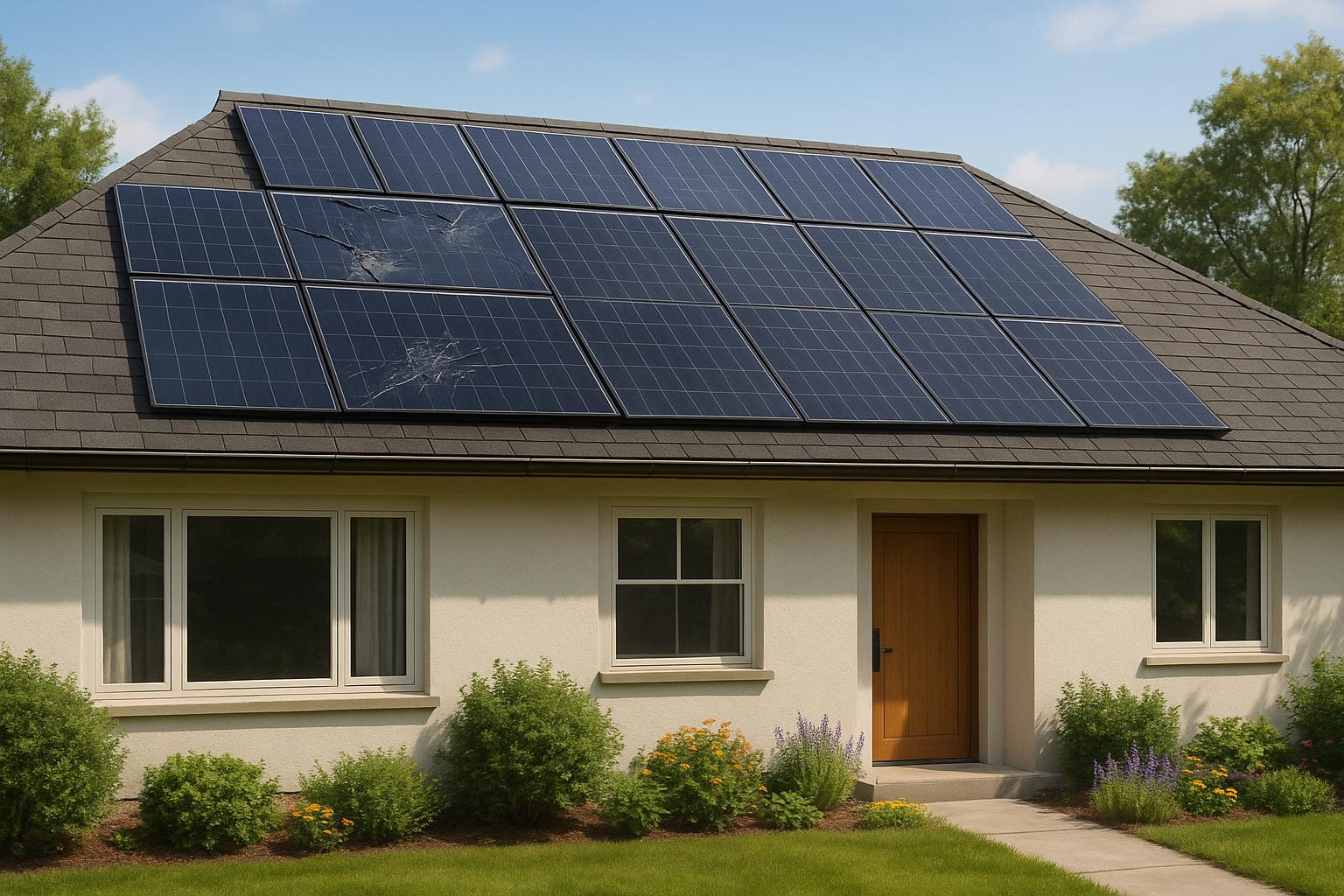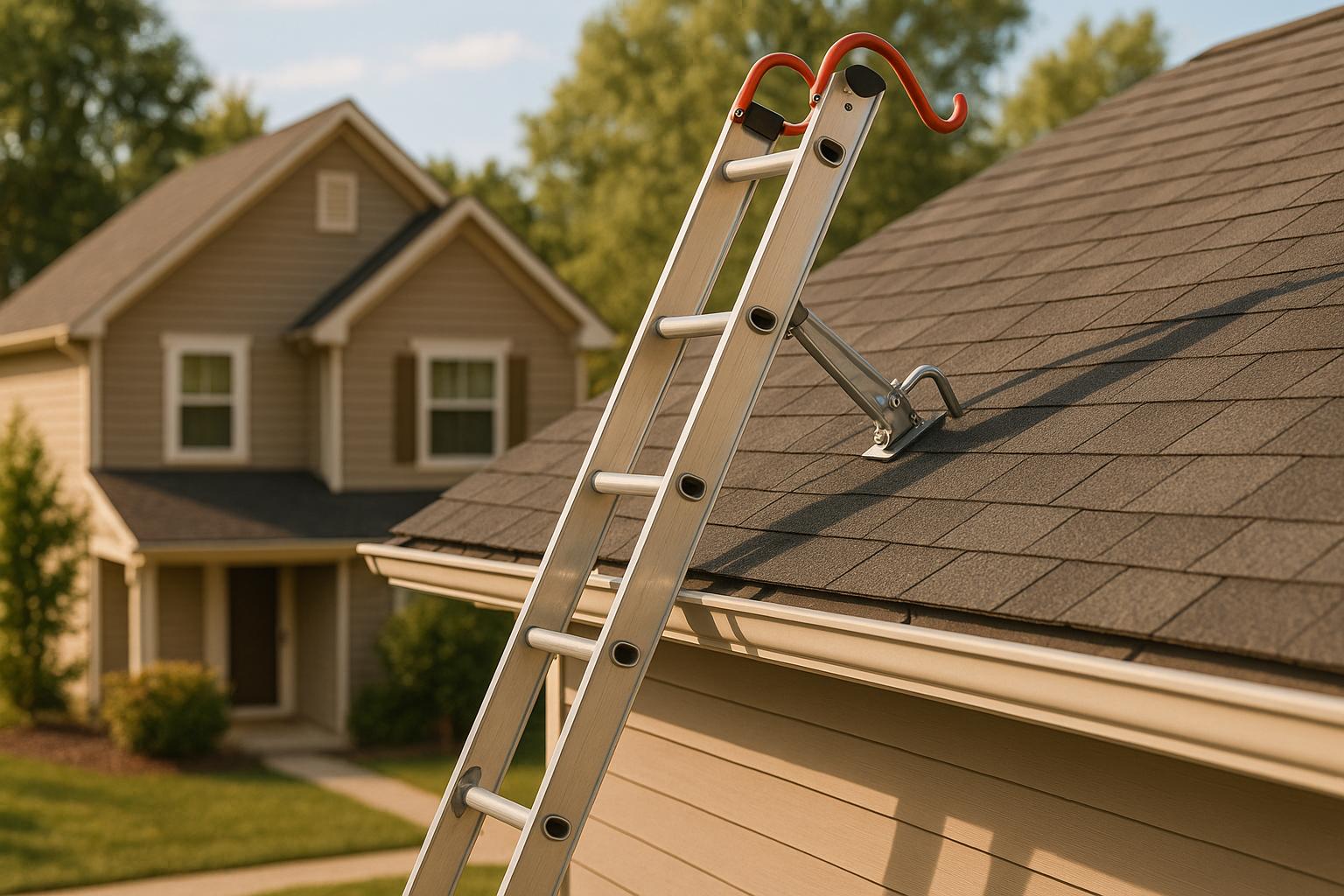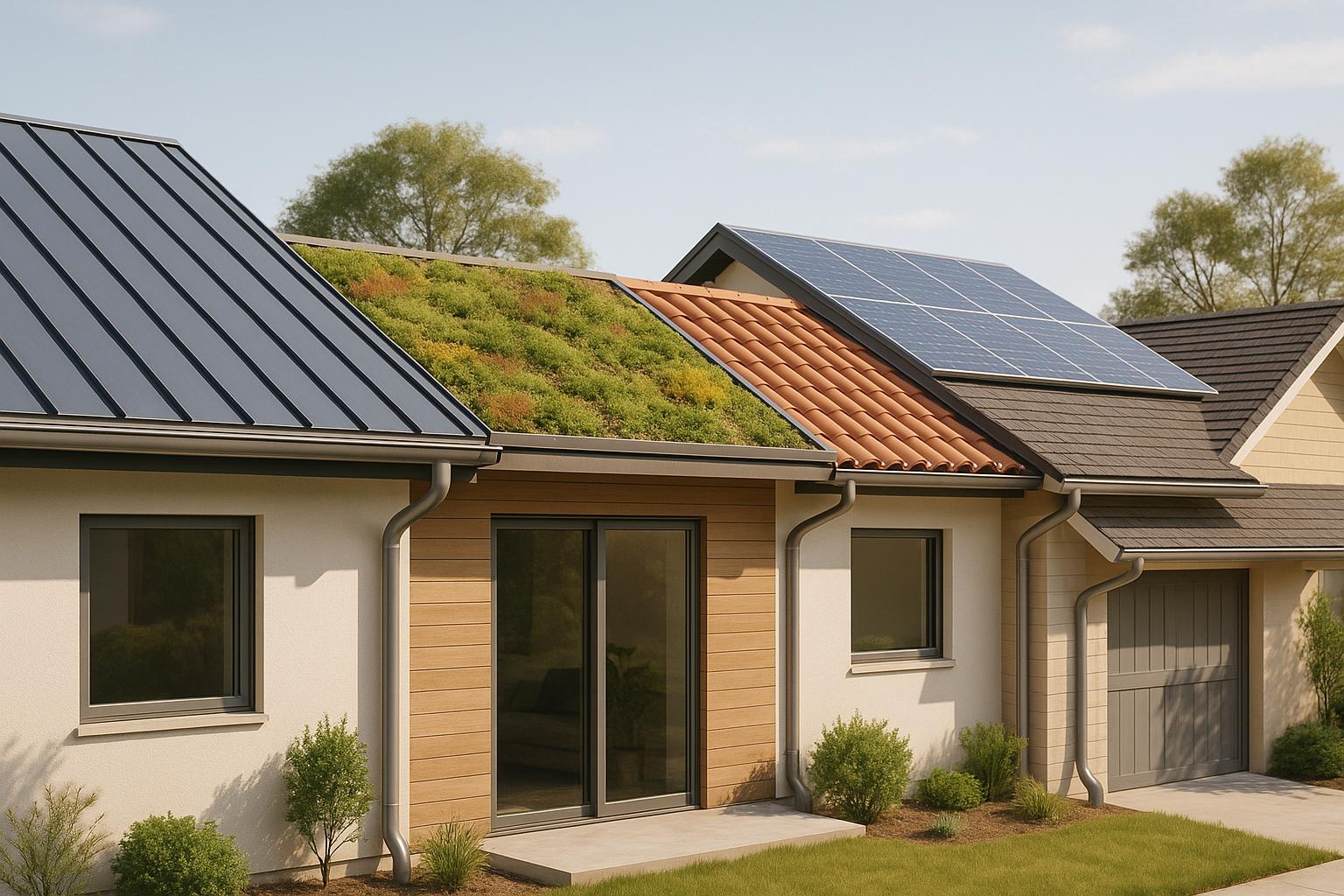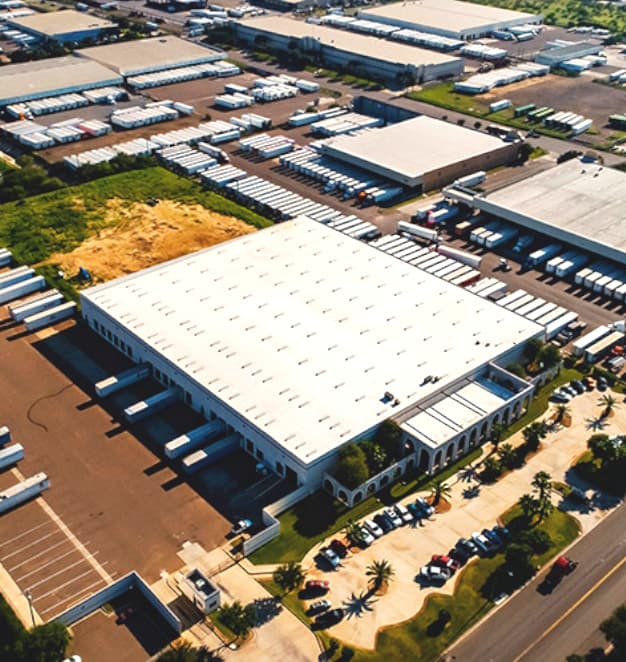Homeowners and businesses in Los Angeles need effective roof ventilation to combat high temperatures, reduce energy costs, and protect their roofs. Without proper ventilation, attic temperatures can soar to 150°F+, leading to higher cooling bills and faster roof wear. Here are the top 5 systems to consider:
- Ridge and Soffit Vent System: Combines ridge vents at the roof peak with soffit vents under eaves for natural airflow. Low maintenance and energy-efficient.
- Static Vents (Box Vents): Simple, cost-effective vents placed near the roof peak to release hot air. Best for smaller spaces.
- Powered Attic Ventilators: Electric or solar-powered fans actively lower attic temperatures. Ideal for homes needing extra cooling.
- Universal Flat Tile Roof Vents: Designed for flat tile roofs, these vents balance airflow while blending with roof aesthetics.
- Soffit Vents: Positioned under eaves, they draw in cool air to complement exhaust vents for balanced ventilation.
Each system offers unique benefits tailored to LA’s warm, dry climate. Proper installation and regular maintenance ensure long-term performance and energy savings.
Quick Comparison:
| System | Key Features | Ideal For | Cost Range |
|---|---|---|---|
| Ridge & Soffit Vents | Natural airflow, no moving parts | Most roof types | $530–$1,075 |
| Static Vents (Box Vents) | Simple, low-cost | Small spaces, complex roofs | $55–$200/vent |
| Powered Attic Ventilators | Electric/solar-powered fans | High cooling needs | $265–$1,000 |
| Universal Flat Tile Vents | Blends with flat tile roofs | Spanish-style/flat tile roofs | $55–$250/vent |
| Soffit Vents | Intake vents under eaves | Most homes with exhaust vents | $290–$475 |
Proper ventilation can lower attic temperatures by 30°F and reduce cooling costs by up to 30%. Consult a professional for the best option for your property.
The Science of Roof Ventilation (and Why You Need It)
1. Ridge and Soffit Vent System
The ridge and soffit vent system is a smart ventilation solution tailored for Los Angeles properties. It pairs ridge vents, installed along the roof’s peak, with soffit vents located beneath the eaves. Together, they create a natural airflow cycle that suits Southern California’s climate perfectly.
This system works without electrical components or moving parts. Ridge vents release hot air from the attic’s highest point, while soffit vents bring in cooler outside air, ensuring consistent ventilation throughout.
"Ridge vents help to maintain the temperature, therefore reducing the need for air conditioning." – laroofingspecialist.com
Energy Efficiency
During the sweltering summer months, attic temperatures can climb to a scorching 150°F. By promoting constant airflow, this system helps reduce cooling demands and lowers energy bills.
Compatibility with Roof Types
Ridge and soffit vents are versatile and compatible with most roof types common in Los Angeles, such as asphalt shingle, tile, and metal. Installation is often straightforward since ridge vents eliminate the need to cut additional holes in the roofing materials or alter the underlayment. Running the full length of the roof, these vents ensure even airflow, preventing hot spots, moisture buildup, and temperature inconsistencies. Their scalability makes them a practical choice for both residential and commercial properties with varying ventilation needs.
Effectiveness in LA’s Climate
Los Angeles’ warm, dry climate amplifies the benefits of ridge and soffit vent systems. The natural temperature differences between the inside and outside create a year-round convection process that keeps air moving.
"Proper roof ventilation allows your roof to ‘breathe,’ facilitating the natural flow of air in and out of your attic or roof space. In hot weather, this is particularly crucial as it helps to expel the extreme heat that can build up, especially in areas with intense sunlight." – Horvath Roofing Inc.
By maintaining steady temperatures and managing moisture levels, this system protects the structural integrity of your roof. In LA’s intense heat – where attic temperatures often exceed 120°F – this airflow not only extends your roof’s lifespan but also improves indoor comfort.
Cost and Maintenance Requirements
Ridge and soffit vent systems are a low-maintenance, cost-effective investment. The primary upkeep involves periodic inspections to clear debris like leaves, dust, or insulation that might obstruct airflow. Proper installation is key, as building codes typically require one square foot of ventilation for every 300 square feet of attic space to ensure efficiency.
Prime American Roofing advises annual inspections to check for blockages and verify that the system is working effectively. With their durability and energy-saving advantages, these systems provide a solid return on investment for both homes and businesses in the Los Angeles area.
2. Static Vents (Box Vents)
Static vents, often called box vents, are simple square or rectangular openings installed directly on the roof. These vents work by letting hot air escape naturally, without relying on electricity. This makes them a dependable and cost-effective option for many Los Angeles homes and businesses.
Box vents are typically placed near the roof’s peak, where warm air tends to rise and collect. When combined with intake vents, like soffit vents, they create a system that keeps air circulating through the attic, preventing heat buildup.
Energy Efficiency
An attic can reach temperatures as high as 150°F, which forces air conditioners to work harder and increases energy bills. Static vents help solve this problem by allowing hot air to escape naturally. This reduces the strain on air conditioning systems and helps keep energy costs in check – especially useful in Los Angeles’ warm climate.
Effectiveness in LA’s Climate
Los Angeles’ dry, warm weather is ideal for static vents. These vents take advantage of the temperature difference between indoor and outdoor air to maintain steady airflow. California’s building codes also require proper ventilation, with at least 1 square foot of ventilation for every 150 square feet of attic space. Since moisture is rarely a concern in LA, box vents are a practical choice for both residential and commercial properties.
Cost and Maintenance Requirements
Box vents are a popular choice because they’re affordable and require minimal upkeep. They cost less upfront compared to powered ventilation systems and don’t add to electricity bills. To keep them functioning properly, it’s important to inspect them regularly for blockages like leaves or debris. Prime American Roofing recommends scheduling yearly inspections to ensure your vents stay clear and efficient.
The number and placement of box vents depend on the size and layout of your attic. Consulting a roofing professional can help determine the best setup for your home. While box vents are an economical option for smaller spaces, having too few can lead to poor ventilation. Still, their simplicity and reliability make them a solid choice for many Los Angeles properties.
3. Powered Attic Ventilators (Mechanical Vents)
Powered attic ventilators use fans – either electric or solar-powered – to push hot air out of your attic, helping to lower temperatures in Los Angeles’ intense heat. These systems come in two main types: electric models that connect to your home’s power supply and solar-powered units that harness energy from the sun. Depending on your home’s layout and ventilation needs, they can be installed on the roof or in gable walls. Let’s break down how these ventilators contribute to energy savings and roof protection.
Energy Efficiency
By reducing attic temperatures by as much as 50°F, powered attic ventilators can lower your home’s overall temperature by about 10°F, which could cut your air conditioning costs by up to 30%.
"Attic fans maintain cooler attic temperatures and lessen the load on your air conditioner." – LA Construction Heating and Air
Solar-powered models take efficiency a step further by operating without increasing your electricity bill. Some advanced units even come with thermostats that automatically activate the fan based on temperature, ensuring they run only when needed, which maximizes savings.
Compatibility with Roof Types
Beyond energy savings, proper installation and compatibility with various roof styles enhance these systems’ performance. Powered attic ventilators are suitable for most roof types common in Los Angeles, including tile, shingle, and flat roofs. Roof-mounted fans tend to be more efficient but usually require professional installation, while gable-mounted fans are a better fit for DIY enthusiasts.
For the best results, these systems need sufficient intake ventilation, typically provided through soffit vents. The general guideline is to achieve at least 10 full air exchanges per hour. Prime American Roofing advises consulting professionals to determine the right placement and size, as factors like attic dimensions, roof slope, and existing ventilation significantly impact effectiveness.
Effectiveness in LA’s Climate
Los Angeles’ hot and dry climate makes powered attic ventilators especially effective. During the summer, they help expel excess heat from the attic, while in the winter, they reduce moisture buildup that can lead to mold and structural damage.
"A Solar Attic Fan is a great to make your house more energy efficient… It works by pulling hot air and moisture out of your attic vents keeping your home cooler and reducing cost associated with air-conditioning. Reducing the heat in your attic can protect your attic from moisture damage and mold which can contribute to health problems." – LA Solar Group
Solar-powered units are particularly well-suited for Los Angeles, as they perform best during the sunniest and hottest parts of the day – precisely when cooling is most needed. Additionally, these systems help protect your roof by preventing heat-related damage to the wooden structure beneath.
Cost and Maintenance Requirements
Powered attic ventilators combine performance with manageable costs and maintenance. Prices range from $100 for DIY installations up to $1,500 for professional setups, with solar models typically costing between $200 and $500 plus installation fees.
Once installed, these systems require little maintenance. However, occasional cleaning of the fan blades and checking for any blockages can ensure they operate efficiently. If the motor needs replacing, costs range from $150 to $650, including labor, with the motor itself priced between $50 and $250. These ventilators generally last 10 to 15 years, offering long-term value. Professional installation labor typically costs $80 to $100 per hour, while repair expenses average around $301.
With their energy savings and minimal upkeep, powered attic ventilators are a practical and cost-effective option for many Los Angeles homes.
sbb-itb-d1d6490
4. Universal Flat Tile Roof Vents
Universal flat tile roof vents are a flexible solution designed for Los Angeles homes and businesses with flat tile roofs. These vents work as both exhaust and intake vents, giving you the ability to create a balanced ventilation system tailored to your property’s specific layout and airflow requirements.
What sets these vents apart is their dual functionality. The Lomanco Universal Flat Tile Roof Vents feature a low-profile design that blends seamlessly with existing roof tiles. Plus, they can be painted to match your roof’s color, ensuring they integrate smoothly with various flat tile roof designs common in LA.
Compatibility with Roof Types
These vents are built to fit most flat tile roof styles typically found in Los Angeles. Whether your roof was installed with or without battens, they provide a versatile solution suitable for a wide range of roofing projects.
Lomanco models are particularly well-suited for flat tile roofs, making them a practical choice for both residential and commercial properties in the area. This adaptability is especially valuable given the prevalence of flat tile roofs across Los Angeles.
Energy Efficiency
Universal flat tile roof vents play a key role in improving your property’s energy efficiency by ensuring proper airflow in your attic. Depending on the model, the Lomanco Universal Flat Tile Vents provide a Net Free Area (NFA) of 91 to 107 square inches, which helps ventilate your attic and release trapped heat. This can significantly lower cooling costs during LA’s hot summers.
In colder months, these vents help prevent moisture buildup, which can damage insulation and reduce its effectiveness. By maintaining consistent indoor temperatures throughout the year, they contribute to lower energy bills and support environmentally friendly building practices.
Effectiveness in LA’s Climate
Los Angeles’ warm and dry climate makes ventilation systems like these especially effective. Universal flat tile roof vents ensure continuous airflow, helping to reduce moisture buildup that could weaken your roof’s structure over time.
Constructed from high-quality metal, these vents are built to withstand the challenges of Southern California’s environment, including rust, corrosion, and intense UV exposure. Their durability ensures reliable performance despite the region’s strong sun and temperature swings.
The vents’ low-profile design allows them to blend with flat tiles while maintaining excellent airflow. This combination of function and aesthetics makes them an ideal choice for properties in Los Angeles, where both appearance and performance are important.
Cost and Maintenance Requirements
Universal flat tile roof vents are an affordable and low-maintenance option for effective ventilation. O’Hagin Vents Universal Flat Tile models are priced between $45.10 and $73.70 per unit, making them a budget-friendly choice.
To keep these vents performing well, occasional maintenance is necessary. This includes checking for debris, blockages, or damage and clearing any obstructions to maintain proper airflow and prevent moisture buildup.
Prime American Roofing suggests scheduling professional roof inspections once or twice a year to catch potential issues early. This proactive approach ensures your ventilation system remains efficient and extends the lifespan of your roof.
In addition to optimizing energy performance, these vents protect your roof’s longevity, making them a smart investment for properties facing Southern California’s demanding climate.
5. Soffit Vents
Soffit vents are a key piece of the roof ventilation puzzle, acting as the intake system that balances the airflow created by exhaust vents. Positioned under the eaves of your roof, these vents allow fresh air to flow into the attic. When paired with ridge vents or similar exhaust systems, they create a well-rounded ventilation setup that helps keep your home comfortable and energy-efficient.
By drawing in cool, fresh air from outside, soffit vents work hand-in-hand with exhaust vents to maintain a steady circulation of air. This is particularly valuable for homes in Los Angeles, where summer temperatures can soar and seasonal changes can put a strain on indoor comfort.
Compatibility with Roof Types
Soffit vents are highly adaptable and can be installed on most roof types commonly found in Los Angeles. Whether your home features tile roofing, asphalt shingles, or other materials, soffit vents can typically be integrated into the design, provided the architecture allows it.
There are two main types of soffit vents to consider:
- Continuous soffit vents: These run along the entire roofline, offering consistent airflow.
- Individual soffit vents: Smaller, rectangular units installed at intervals (usually 5 to 6 feet apart) to suit specific architectural needs.
Roofing professionals often recommend soffit vents as an effective intake option, especially when paired with ridge vents for exhaust. Their compatibility with various roof styles and designs makes them a practical and energy-conscious choice.
Energy Efficiency
Soffit vents play a big role in reducing energy costs, especially during Los Angeles’ hot summers. By drawing in cooler air and helping to expel heat, they ease the burden on HVAC systems, which can lower utility bills. Beyond cooling, proper ventilation helps regulate temperatures throughout the home and prevents moisture buildup, which can lead to mold, mildew, and wood rot. Additionally, good ventilation slows the wear and tear on roofing materials, extending their lifespan.
Effectiveness in LA’s Climate
Los Angeles’ warm, dry climate makes attic ventilation essential. During the summer, attic temperatures can skyrocket, leading to uncomfortable indoor conditions and higher cooling expenses. Soffit vents bring in cooler air, which, when combined with exhaust systems, helps push out the trapped hot air, maintaining a more balanced attic temperature.
Even in the milder winters, soffit vents help expel moist air, reducing the risk of mold and mildew. Surprisingly, experts estimate that nearly 70% of U.S. homes fail to meet basic ventilation standards. The International Residential Code (IRC) suggests at least 1 square foot of ventilation for every 300 square feet of attic space if a vapor barrier is present, or 1 square foot for every 150 square feet without one. To ensure proper airflow, you’ll need 1 square foot of air intake at the soffit for every 150 square feet of roof deck.
Cost and Maintenance Requirements
Soffit vents are not only budget-friendly but also require minimal upkeep. Unlike powered ventilation systems, they don’t rely on mechanical components, making them a dependable, long-term solution.
To keep them performing well, make sure they aren’t blocked by insulation, as this can restrict airflow. Using rafter vents can help maintain proper circulation. Regular inspections of your attic and ventilation system are a good idea to catch potential issues early. Check that soffit vents are free from debris, leaves, or other obstructions, and seal any gaps or cracks in the attic to optimize airflow.
Prime American Roofing advises scheduling professional inspections to confirm your ventilation system meets current building codes and is functioning efficiently. Staying proactive with maintenance can prevent costly repairs and keep your home comfortable, even in Southern California’s challenging climate.
System Comparison Chart
Here’s a breakdown of key details for various roof ventilation systems tailored to Los Angeles properties. This chart highlights essential features, advantages, drawbacks, and ideal applications, helping you choose the right option for Southern California homes.
| Ventilation System | Key Features | Main Benefits | Drawbacks | Best Uses | Cost Range |
|---|---|---|---|---|---|
| Ridge and Soffit Vent System | Continuous ridge vent paired with soffit intake vents | Provides consistent ventilation across the attic with effective vertical airflow | Requires ridge and eave access; potential for storm leaks | Homes with a clear roof ridge | $530-$1,075 installed |
| Static Vents (Box Vents) | Multiple small vents placed strategically | Easy to install and adaptable for complex roof designs | Limited capacity per vent; prone to cracking over time | Roofs with valleys or hip configurations | $55-$200 per vent installed |
| Powered Attic Ventilators | Electric fans with temperature controls | Actively lowers attic temperatures by 20°F or more | Higher energy usage; mechanical parts may fail over time | Homes needing extra ventilation power | $265-$1,000 installed |
| Universal Flat Tile Roof Vents | Low-profile vents designed for tile roofs | Blends with roof aesthetics; weather-resistant | Limited to specific roof types; requires professional installation | Spanish or flat tile roofs common in LA | $55-$250 per vent installed |
| Soffit Vents | Intake vents installed under roof eaves | Facilitates cool air intake; complements exhaust systems | Can get blocked by debris; needs a clear airflow path | Ideal for most homes when paired with ridge vents | $290-$475 installed |
This comparison underscores the importance of selecting a system tailored to your property’s needs. For instance, ridge vents offer widespread coverage at reasonable costs, while static vents are a budget-friendly choice for complex roof designs.
"The nice thing about ridge vents is that they are not powered by electricity, so there is nothing to fail, no motors, no fan belts, etc. It requires less maintenance, less noise. It just works." – Keith Sheehy, roofing expert
In Los Angeles, attic ventilation is crucial due to the region’s climate. Proper ventilation can lower attic temperatures by as much as 30°F, easing the strain on air conditioning during hot summers.
Professional installation typically costs between $45 and $75 per hour, and experts recommend combining intake and exhaust systems for the best results. Additionally, building codes require a minimum net free ventilation area of 1/150 of the vented space’s total area.
These insights can help you find the ventilation solution that fits your property’s specific needs while keeping it comfortable and energy-efficient.
Conclusion
Selecting the right roof ventilation system for your Los Angeles property is key to maintaining comfort, protecting your roof, and cutting down on energy costs in Southern California’s demanding climate. The region’s intense heat and occasional moisture make proper ventilation essential for controlling attic temperatures, reducing humidity, and preventing roof damage over time.
Each ventilation system discussed offers solutions tailored to these challenges: ridge and soffit combinations provide broad coverage for classic roof designs, static vents adapt well to more intricate layouts, powered attic ventilators offer extra cooling during scorching summer days, universal flat tile roof vents integrate beautifully with LA’s iconic Spanish-style homes, and soffit vents play a vital role in intake airflow for a balanced system.
By effectively managing attic temperatures, a well-ventilated roof can ease the strain on your air conditioning system, which may lead to noticeable energy savings. This highlights the importance of proper installation and regular upkeep to ensure long-term performance.
"Proper ventilation systems in your roofing are a game-changer for energy efficiency and overall home health." – Sierra Roof Inc.
Working with skilled professionals is crucial. Local roofing experts are familiar with LA’s unique weather patterns, can recommend the best ventilation options, ensure adherence to local building codes, and provide ongoing maintenance to keep the system running at its best .
For a solution tailored to Los Angeles’ specific needs, consulting with experienced professionals like Prime American Roofing is a smart move. Their expertise in Southern California roofing, combined with quality materials and strong warranties, ensures reliable results and peace of mind for homeowners.
FAQs
What should I consider when selecting a roof ventilation system for my Los Angeles home?
When choosing a roof ventilation system for your home in Los Angeles, you’ll want to take into account a few key factors: the local climate, the size of your attic, and your home’s specific ventilation requirements. Common options include ridge vents, turbine vents, and solar-powered vents. These systems can help keep your attic cooler, reduce moisture buildup, and even improve your home’s overall energy performance.
It’s also essential to ensure the system complies with local building codes, which typically call for 1 square foot of ventilation for every 150 square feet of attic space. Beyond functionality, consider energy efficiency and how the system blends with your home’s design – important aspects for ensuring optimal performance in Southern California’s warm weather.
What are the differences between powered attic ventilators and passive roof ventilation systems?
Powered attic ventilators use electric or solar-powered fans to push hot air out of your attic. They’re effective at cooling and can even help extend the life of your roof. But keep in mind, they come with some trade-offs. Regular upkeep, like motor inspections and cleaning, is a must. Plus, since they rely on electricity, you might notice a bump in your energy bills.
On the other hand, passive ventilation systems – like ridge vents or soffit vents – work with natural airflow. These systems are low-maintenance, energy-efficient, and more budget-friendly over time because they don’t need electricity to function. While powered ventilators might suit certain situations, passive systems are often the better option for most homes and businesses, offering simplicity and ease of upkeep.
Why is roof ventilation so important in Los Angeles, and what are the key benefits of installing a proper system?
Roof ventilation plays a crucial role in Los Angeles, where hot summers and bouts of humidity are common. Without adequate airflow, heat and moisture can accumulate in your attic, potentially causing problems like mold growth, structural damage, and increased energy costs.
A well-designed ventilation system helps manage indoor temperatures, minimizes moisture buildup, and boosts your home’s energy efficiency. This not only protects your roof but also ensures a more comfortable living environment throughout the year, even in Los Angeles’ warm climate.

